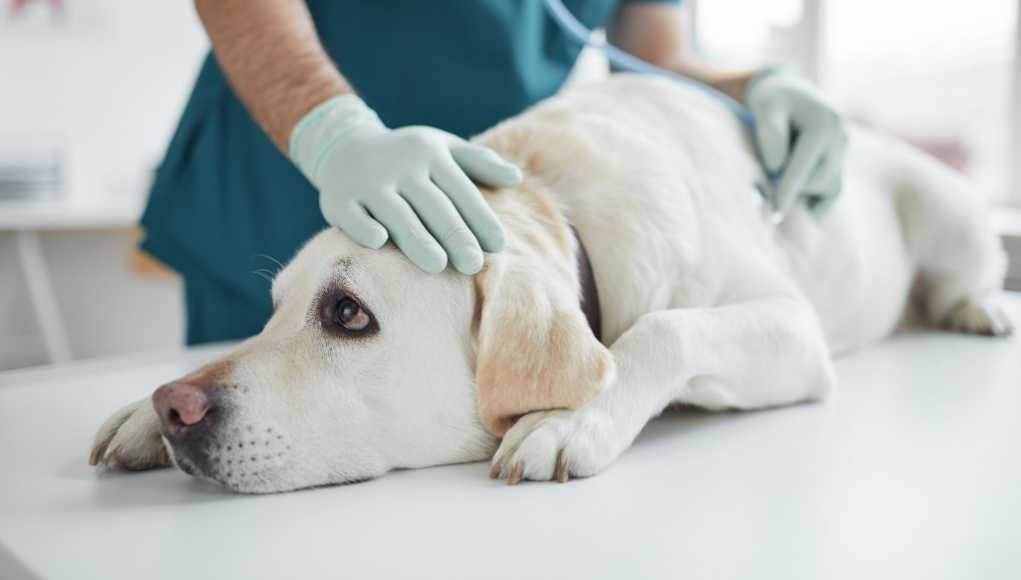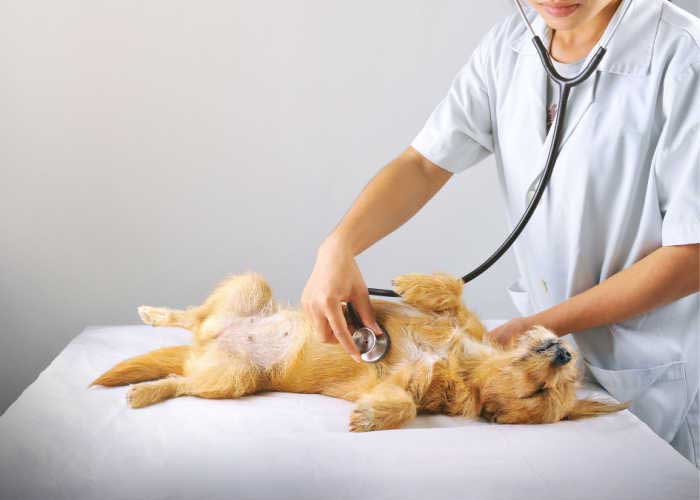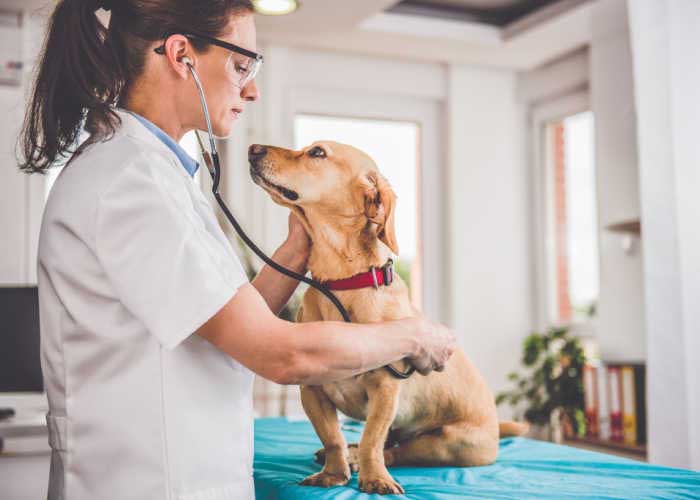Table of Contents
- Bile Duct Cancer in Dogs
- Is Cholangiocarcinoma Benign or Malignant?
- Bile Duct Cancer Signs and Symptoms
- Diagnosis of Bile Duct Cancer in Dogs
- Treatment of Bile Duct Cancer in Dogs
- Bile Duct Cancer Prognosis
- Recovery from Bile Duct Carcinoma
- FAQs about Cholangiocarcinoma
- Bile Duct Cancer in Dogs Final Thoughts
Dogs get cancer at roughly the same rate as humans. But how do you recognize bile duct cancer in dogs when it is not seen with the naked eye?
Cancer is fatal not only to us but also to our canine companions. In fact, it is the leading cause of death in dogs.
It is estimated that 1 in 4 dogs will develop cancer at some point. Out of their entire population, almost 50% of them will develop the disease over the age of 10.
While millions of dogs develop tumors yearly, pets today have a better chance of being treated successfully than before. Thanks to medical studies of canine cancer, research gives hope in saving our furry friends’ lives.
Cancer in dogs has been a huge part of the AKC Canine Health Foundation’s research portfolio, providing breakthroughs that allow advances in early recognition, diagnosis, and treatment. For years, the organization helped better understand dogs’ possible conditions and guided owners with the treatment options available.
Like all forms of cancer, a diagnosis of the disease can be heartbreaking for fur parents. Since the treatment greatly depends on the type of cancer detected, we will focus today on bile duct cancer in dogs.
Bile Duct Cancer in Dogs
Also known as cholangiocarcinoma, it is a type of cancer that involves tumors originating from the bile ducts.
Bile is a fluid produced in the liver, stored in the gallbladder, and used within the small intestine for digestion. This digestive fluid moves through the body through small tubes called bile ducts.
This means that the disease forms in those thin tubes that connect the liver to the gallbladder and the small intestine. Bile duct carcinoma in dogs happens when unusual cells grow out of control inside the bile ducts.
When cancer starts to grow, it prevents the bile from passing. This causes a buildup of the digestive fluid in the liver and hinders the digestion process.
All dogs are at risk of developing this type of cancer but not commonly seen in any specific breeds. However, it seems to target female and elderly dogs more than the younger ones.
You may wonder what causes bile duct cancer in dogs. Well, you should know that the cause is largely unknown.
Although no one knows exactly why the disease develops, the suspected causes include environmental exposure to carcinogens and severe infection from parasitic infestations.
Is Cholangiocarcinoma Benign or Malignant?
Though it is difficult to predict how a tumor behaves, cholangiocarcinoma in dogs is a malignant form of cancer. It is aggressive, with the risk of metastasis up to 88%.
Bile duct cancer can spread rapidly and widely to the abdominal lining, bladder, diaphragm, intestines, kidneys, and lymph nodes close to the liver, lungs, pancreas, and spleen.
It can be difficult to treat effectively even if diagnosed before spreading due to its location. In dogs, the mass is more likely to be found in the left lobe of the liver, which is difficult to completely remove by surgical means.
Animals with the disease usually have a guarded condition to poor prognosis. Thus, bile duct carcinoma in dogs is a serious concern.
While treatment depends on the progression of the disease, surgery, chemotherapy, and radiation are strongly suggested to improve the chance of survival.
Bile Duct Cancer Signs and Symptoms
Cholangiocarcinoma in dogs frequently produces the main symptom of a swollen abdomen, which can be due to enlarged liver or fluid in the abdomen.
The tumor creates a blockage that can force the bile to enter the bloodstream, thus some other signs associated with the disease include:
- Vomiting
- Weight loss
- Excessive thirst
- Excessive urination
- Lack of energy
- Lack of appetite
- Jaundice, in which the mucous membranes, skin, and the whites of the eyes turn yellow
See a vet for a proper diagnosis and course of treatment once you see symptoms that your dog might be suffering from bile duct cancer.
You may discuss additional testing to determine and plan the treatments that fit your pup’s needs. Talk about how large the cancer is and whether it has spread to other organs.
Regarding the treatment details, you may raise your concern about which options are recommended. You can also ask how soon you can start the treatment and the potential side effects.
Diagnosis of Bile Duct Cancer in Dogs
At the start of the visit, the veterinarian will perform a thorough physical examination of your pet, checking the build-up of fluid in the belly.
Aside from the fluid accumulation, he will take into account the health history and possible incidents that might have led to this condition.
Provide the onset of the symptoms to aid the doctor in diagnosis. Be sure to report any exposure to toxins if your dog had encountered such.
Following the initial exam, the vet will order a chemical blood profile to measure albumin, bilirubin, cholesterol level, and liver enzymes. He will also conduct a complete blood count, urinalysis, and an electrolyte panel.
In addition, a test for a-Fetoprotein concentration will help to confirm whether the condition is due to cancer. To test whether the blood is clotting properly, a coagulation profile will be ordered, too.
Furthermore, x-rays will locate and identify the mass. An abdominal ultrasound will also be taken to observe the liver as well as surrounding organs to detect metastasis.
If your doctor suspects cancer, the lungs will need to be examined using imaging tests. He will then perform a liver biopsy to confirm the suspected disease.
The biopsy will be conducted by fine needle aspiration, but in some cases, the vet may need a larger tissue sample through a laparoscope.
This requires a small surgical incision in the abdominal cavity using a tubular diagnostic tool that is equipped with a camera and forceps for collecting tissue.
If your pup has fluid accumulation in its abdomen, your doctor will draw samples of it to send to the lab along with the tissue sample for analysis.
Treatment of Bile Duct Cancer in Dogs
Bile duct carcinoma in dogs happens when cells in the bile ducts develop changes causing them to multiply out of control. These cells form a mass or tumor that can invade and destroy body tissues.
While there is no preventive care, treatments give hope in saving our canine companions’ lives.
Chemotherapy has proven to be effective to slow the spread of cancer and decrease your fluffball’s discomfort.
If the tumor is detected early, it may be removed surgically. If the tumor is too large for removal, other approaches may be done such as radiation therapy or ablation to treat the spread of cancer.
The key to managing cancer is early detection. Catching it early is critical for successful treatment, recovery, and quality of life – making visits to the vet important for annual or semi-annual wellness.
However, cholangiocarcinoma is often diagnosed when it's advanced, making successful treatment difficult to achieve.
Bile duct cancer in dogs is difficult to treat, as chemotherapy is only a palliative tool rather than a curative.
On the other hand, surgery is the recommended treatment to remove cancer. Surgical removal of the tumor requires getting the affected section, which is up to 75% of the liver, considering the remaining liver tissue is normal and healthy.
You will need to consult with your veterinarian or the oncologist if your pet is a candidate for surgery, depending on how severe cancer has spread and how much of the liver is affected.
Bile Duct Cancer Prognosis
The success of the treatment will depend on how far along it is when your dog is diagnosed.
The bile duct is deep inside the body, so unlike the other cancers that are easy to see with the naked eye, signs will not be known in the early stages.
Chemotherapy and surgical removal remain the primary therapeutic options. But even with successful surgery, the prognosis remains poor due to the rate of metastasis and no treatment found to cure cancer.
Recovery from Bile Duct Carcinoma
Your dog will be monitored in an intensive care unit after the procedure to administer medication. Fluids and antibiotics will help control pain and prevent infection.
At home, you will need to regularly clean and monitor the surgical wound to ensure proper healing. Your doctor may require antibiotics and pain medications.
Since your pup’s body is weak from fighting the disease and especially after the surgery, you can also do homemade dog food that is easy to digest. Make a special diet that will meet your dog’s nutritional needs.
When it comes to recovery after chemotherapy, your dog may have a reduced appetite, vomiting, or diarrhea that may last a few days.
Aside from the low risk of hospitalization after the treatment, there are medications to help control the side effects encountered.
Whether it is through chemotherapy or pain management, it is important to know how to take care of your pet. Keep your fur baby as comfortable as possible.
You will need to return to your vet for follow-up exams.
After the initial care, the doctor will have to measure liver enzyme activity in the bloodstream. He will also check the status of your dog’s organs using thoracic radiographs and abdominal ultrasounds.
RELATED: Homemade Dog Food for Cancer
FAQs about Cholangiocarcinoma
Can dogs get bile duct cancer?
Just as in humans, dogs are at risk of cholangiocarcinoma. The disease occurs more often in the intrahepatic bile ducts within the liver’s left lobe.
Over time it grows through the bile duct wall, invading nearby blood vessels, organs, and other structures.
What are the symptoms of bile duct cancer in dogs?
There are no early signs of bile duct carcinoma. Until it reaches the later stages, the symptoms can include abdominal pain, excessive need to urinate, excessive thirst, lack of appetite, seeming less active than usual, jaundice, vomiting, and weight loss.
What is the survival rate of bile duct cancer in dogs?
Cholangiocarcinoma is extremely aggressive. As per statistics, less than 10% of patients survive five years after diagnosis.
If diagnosed at an early stage, the survival rate is 25%. Survival is even lower for patients diagnosed at a metastatic stage.
If cancer has spread to the lymph nodes, the 5-year survival rate is 8%. Once it has spread to a distant part of the body, the rate goes down to 2%.
Bile Duct Cancer in Dogs Final Thoughts
Cancer, such as bile duct cancer in dogs, is the leading diagnosis despite doing everything we can to provide for our pet’s well-being in the best ways possible.
All dogs, whether mixed or purebred, are at risk for developing cancer. They fall victim to different types of canine cancer since it can take many forms and affect the bone, blood, or body tissues.
An accurate diagnosis is crucial to provide the most appropriate treatment and the best prognosis.
Cancer prevalence increases with age and certain breeds are susceptible to specific kinds of cancers. But this should not necessarily mean a death sentence to our dogs.
According to Dr. Ashly LaRoche of the Animal Hospital of Statesville, there have been a lot of advancements in cancer studies that were not available 20 years ago. This means doctors can now do so much more for our canine companions to extend their lives.
Newer treatments mean the survival rate will improve over time. There are all kinds of methods that they can perform such as surgery, radiation, chemotherapy, immunotherapy, antibody therapy, and vaccine therapy.
Is there anything that we can help with?
Aside from wanting our furry friends to be well, we can support canine cancer research through donations to help improve canine health. It is through this generous support that organizations can make progress in their understanding of canine cancer.
Aside from AKC Canine Health Foundation, many organizations fund research in veterinary oncology, such as the ACVIM Foundation, Morris Animal Foundation, and EveryCat Health Foundation.
Our donations help fund the search for the cure. Research grants have helped scientists study cancer at the cellular level – providing our furry friends with early diagnosis, more treatment options, and the chance at a high quality of life.

















